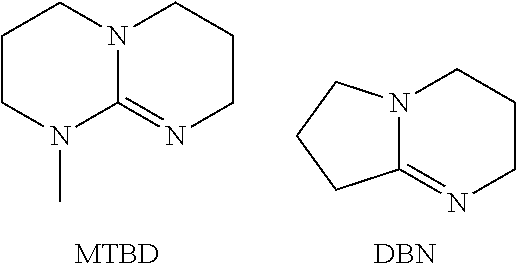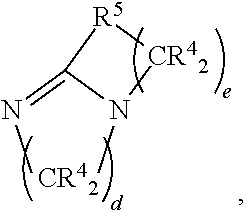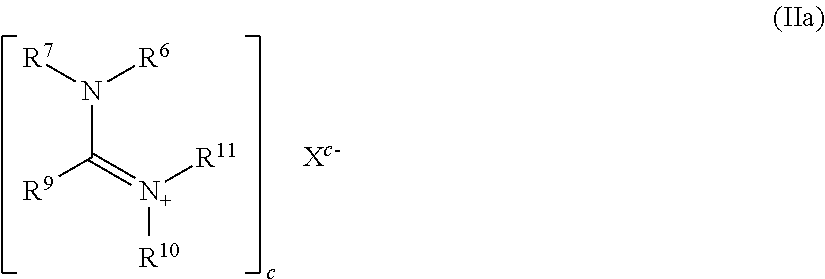Ester-Functional Silanes And The Preparation And Use Thereof; And Use Of Iminium Compounds As Phase Transfer Catalysts
a technology of ester functional silanes and silanes, which is applied in the field of new ester functional silanes, can solve the problems of not being considered a high-performance catalyst, tetrabutylammonium bromide (tbab), and tetrabutylammonium halides, which may also be thermally unstable at the temperatures needed to produce ester functional silanes, and amine quat salts suffer from being less thermally stable and less efficien
- Summary
- Abstract
- Description
- Claims
- Application Information
AI Technical Summary
Benefits of technology
Problems solved by technology
Method used
Image
Examples
reference examples 1 to 8
General Procedure for Preparation of Quats
[0104]Polyazabicycloalkene quats: alkyl halide quats (iminium salts) were prepared by combining a polyazabicycloalkene (described above) and an alkyl halide. The alkyl halides tested were 2-ethylhexyl bromide, 1-bromobutane, 1-bromooctane, 1-bromododecane, and 1-chlorooctane. The combinations were heated in some instances. Synthesis of the resulting iminium salts is illustrated below for DBU+2-ethylhexyl bromide in the model reactions shown below. The competing reaction of elimination, to form an olefin by-product, accounted for 63% of the reaction mixture, leaving 37% DBU: ethylhexyl bromine quat. This reaction product can be used as a phase transfer catalyst for ingredient c) in the method described above without purification. Alternatively, purification of the DBU quat before use of said quat as the phase transfer catalyst of ingredient c) may be performed by any convenient means, as described above in the specification. Replacing the 2-e...
reference example 1
DBU 2-ethylhexyl Bromide Quat
[0105]To a 15 ml vial were added 3.03 g (19.9 mmol) of DBU and 3.84 g (19.9 mmol) of 2-ethylhexyl bromide. The vial was vortex mixed to form a clear solution and placed in an oven at 80° C., removed and briefly vortex mixed after 7 minutes then returned to the oven. The contents were hazy after 7 minutes. The vial was removed from the oven after 30 minutes. The contents separated into two phases, a thick lower phase and a thinner upper phase. 1H NMR showed the upper phase to be a mixture of starting materials and 2-ethylhexene. By 1H NMR, the crude material lower phase was 37% quat salt and the balance was DBU.HBr and a small amount of 2-ethylhexene. The crude material lower phase was evaluated as a phase transfer catalyst without purification. In a separate preparation, the crude product was purified by dissolution in methylene chloride, washing with deionized (DI) water, drying of the organic layer over MgSO4, and addition of pentane to the organic lay...
reference example 2
MTBD 2-ethylhexyl Bromide Quat
[0106]To a 2 ml vial was added 0.48 g (3.1 mmol) of MTBD and 0.61 g (3.1 mmol) of 2-ethylhexyl bromide. The vial was vortex mixed to form a clear solution and placed in an oven at 104° C., removed and briefly vortex mixed after 14 minutes then returned to the oven. The contents were hazy / opaque after 14 minutes. An additional vortex mix was completed after 30 minutes. The vial was removed from the oven after 138 minutes. The contents separated into two phases, a thick lower phase and a thinner upper phase. 1H NMR showed the upper phase to be a mixture of starting materials and 2-ethylhexene. The crude material lower phase was evaluated as a phase transfer catalyst without purification.
PUM
| Property | Measurement | Unit |
|---|---|---|
| Temperature | aaaaa | aaaaa |
| Temperature | aaaaa | aaaaa |
| Time | aaaaa | aaaaa |
Abstract
Description
Claims
Application Information
 Login to View More
Login to View More - R&D
- Intellectual Property
- Life Sciences
- Materials
- Tech Scout
- Unparalleled Data Quality
- Higher Quality Content
- 60% Fewer Hallucinations
Browse by: Latest US Patents, China's latest patents, Technical Efficacy Thesaurus, Application Domain, Technology Topic, Popular Technical Reports.
© 2025 PatSnap. All rights reserved.Legal|Privacy policy|Modern Slavery Act Transparency Statement|Sitemap|About US| Contact US: help@patsnap.com



